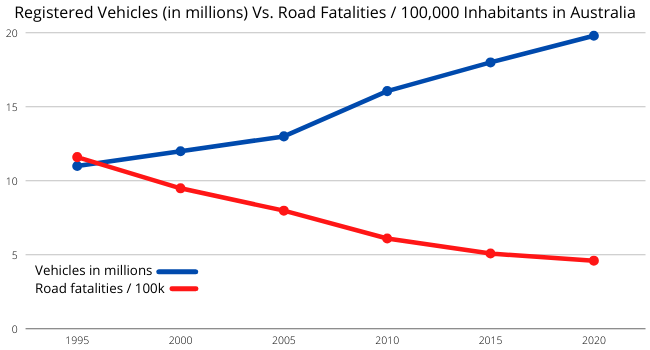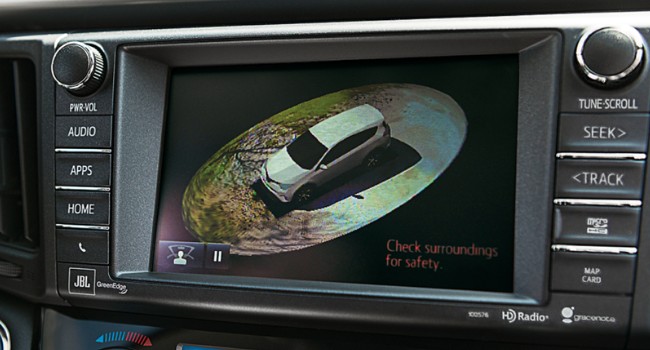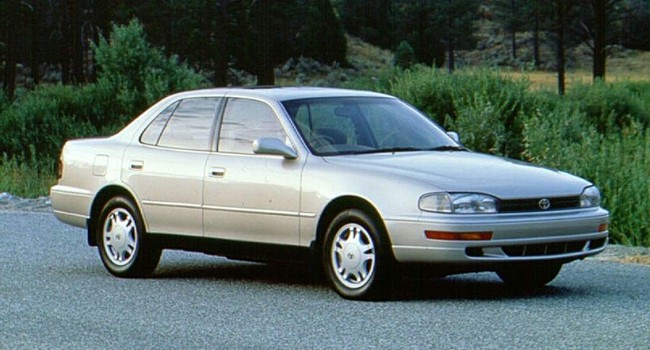June 22, 2021
It may not seem obvious at first glance, but car safety has dramatically improved. Despite growing populations (of people and cars), Australia isn’t the only country reporting spectacular drops in road fatalities.
OnlineLoans.com.au takes a look at the facts and figures to find out why car safety has improved so much.
The gist in 30 seconds
- Australia and the world have significantly increased vehicle fleets while decreasing road fatalities.
- Modern car safety features like Adaptive cruise control, AEB and many more are saving lives. Here’s how they work.
- Pillars and anti-intrusion bars also add to car safety and have significantly improved over the last 30 years.
- Car safety comparison: 1996 Camry Vs 2021 Camry
- Get all the modern car safety features
Stats in 30 Seconds
- 68.5% drop in road fatalities in Australia since peaking in 1970
- Mercedes-Benz CLA, Tesla Model X and Tesla Model 3 among ANCAP’s top performing vehicles in safety
- 18.2 road fatalities per 100,000 inhabitants is the world average, Australia sits at 4.6 per 100,000
- From 1995 to 2020, the number of registered vehicles in Australia increased by around 80%
- From 1995 to 2020, road fatalities per 100k inhabitants in Australia decreased by around 59%

As the above graph shows, the number of vehicles in Australia has dramatically increased, however, road fatalities are fortunately showing an opposite trend.
Other countries are reporting similar trends.
Road Fatalities per 100,000 inhabitants (approx. figures)
| Country | 1995 | 2018 – 2020 | Decrease |
| United States | 15.91 | 11.18 | -29.7% |
| UK | 5.78 | 2.9 | -49.8% |
| Japan | 8.58 | 2.31 | -73% |
Modern vehicle safety improvements
“they can display a full-surround view of the vehicle, almost as if a drone is hovering overhead.”
Playing a major role in road safety is vehicle safety.
Vehicle safety features often fall into two categories; ‘active’ and ‘passive’.
Active car safety = must be activated by the occupants, for example, seatbelts as they have to be put on.
Passive car safety = don’t have to be activated by occupants to be ‘on’. For example, airbags as you don’t need to turn them on each time you drive your car.
Below are some notable safety features that most modern vehicles come standard with and how they improve road safety.
– Adaptive cruise control
First introduced: 1999 by Mercedes
Mainstream adoption: mid-late 2000s
Ideal for highway driving, these systems use radar-based monitoring to adjust the distance from the vehicle in front. Adaptive cruise control has the ability to slow the vehicle down, even coming to a complete stop, as per the vehicle in front.
Further developments include the ability to center the car in the middle of the lane and monitor surrounding traffic.
Adaptive cruise control assists in the monitoring of surroundings and high speeds and applies braking if and when needed.
– Autonomous emergency braking (AEB)
First introduced: 2003 by Honda
Mainstream adoption: late 2000s
Also known as the ‘Collision Avoidance System’, AEB uses sensors to detect objects, like other vehicles and pedestrians, in the vehicle’s path. Upon detecting an object that the system detects as a possible collision, an audible and/or visual warning alerts the driver. If deemed necessary, the system can apply the brakes.
AEB reduces accidents caused by distracted drivers and sudden impacts. More modern systems can also monitor other vehicles approaching from the sides, like at an intersection.
Some studies have shown that these systems reduce front-to-rear crash rates by 43%.
– Lane Departure Warning / Lane Keep Assist
First introduced: 2001 by Nissan (2000 in some US trucks)
Mainstream adoption: mid-late 2000
Although these are often two different systems, they work by keeping vehicles in their lanes. They scan the road, picking up the white lines and alert the driver should they stray out of the lane without indicating.
Lane Keep Assist can gently steer a car back to the center of the lane.
On a gravel road or road with faded or no lines, the system can be turned off.
These systems can help fatigued or distracted drivers and also serve as a reminder to use your turn signal.
Fatigue and distraction are in the top 5 causes of road accidents in Australia.
– Blind Spot Detection
First introduced: 2007 by Volvo
Mainstream adoption: early 2010s
This technology might seem pretty basic compared to some of the others listed, but it acts as a significant safety feature. It works by alerting the driver when another vehicle is in their blind spot.
Some equipped vehicles have visible signals on their wing mirrors, modern versions display a live video feed within the gauge cluster.
Some more advanced systems also monitor rear cross traffic which alerts drivers of vehicles approaching from the sides when reversing.
Pedestrians struck by reversing vehicles is a common occurrence, as are similar incidents with other vehicles in busy car parks.
– 360-degree cameras
First introduced: 2007 by Infiniti (Nissan)
Mainstream adoption: early 2010s
 (source: toyota.com)
(source: toyota.com)
These cameras work by stitching multiple camera views together. Hence the name, they can display a full-surround view of the vehicle, almost as if a drone is hovering overhead.
They primarily assist drivers with parking and often integrate with parking sensors. This may not seem like a personal safety feature, as the systems typically save vehicles from car park dings, but pedestrians also benefit.
Vehicle design has also played a huge role in overall safety.
Anti-intrusion bars, for example, have come a long way over the last 25 (or so) years. They are made of high-strength steel tubes and fitted within a vehicle’s doors. Their job is to absorb the kinetic energy of a side impact, protecting occupants.
Development and modern manufacturing methods have allowed anti-intrusion bars to dramatically reduce side-impact injuries.
Strong pillars help too
It may not be noticeable at first glance, but modern cars have significantly thicker pillars. The pillars in a vehicle are the vertical supports between windows.
 (The A, B and C pillars on a vehicle)
(The A, B and C pillars on a vehicle)
Strong pillars protect occupants in the event of a rollover and add to the overall strength of a vehicle’s chassis. Comparing a vehicle from over 30 years ago to a modern variant, it’s easy to see how pillars have become thicker and reshaped.


But it’s not only new safety tech that keeps drivers safe
“The first fully-electronic ABS braking system was developed for supersonic passenger aircraft, the Concorde.”
Airbags, first introduced in the early 1970s, have proven themselves to be lifesavers.
It’s estimated that airbags have saved around 2,700 Australian lives, 36,000 serious injuries and nearly $20 billion since the early 1990s.
Airbags work by deploying a cushioning ‘bag of air’ which protects occupants in the event of a serious accident. The airbag rapidly inflates by using an explosive gas propellant, then deflates as it absorbs the impact of the occupant.
The airbag inflates in approximately 20 to 30 milliseconds – the average blink of an eye is around 300 – 400 milliseconds.
Using sensors, airbag control units calculate the collision type, speed, angle and severity of an impact to determine which airbags, if any, need to be deployed. All that happens in milliseconds.
Some airbag units can record crash data to assist investigators.
ABS brakes have also added to car safety.
ABS (Anti-lock braking system), as we know it today, was first introduced in the 1978 Mercedes-Benz S Class. The vehicle featured an electronic four-wheel ABS. Interestingly, prior to the S Class, the first fully-electronic ABS braking system was developed for the supersonic aircraft, the Concorde.
ABS brakes prevent the wheels from locking up or skidding during heavy braking. This allows the driver to have more control over a vehicle.
These systems reduce braking distance and improve control on slippery surfaces, such as gravel.
In another ABS quirk, unlike many inventions, the creator, Fiat research engineer, Mario Palazzetti is known as ‘Mister ABS’.
Vehicle safety comparison 1995 to today
The well-known Toyota Camry, seen on roads all around the world, is a vehicle that has made massive improvements in its safety features.
 (1996 Toyota Camry)
(1996 Toyota Camry)
 (Big changes: the 2021 Camry. Source: motortrend.com)
(Big changes: the 2021 Camry. Source: motortrend.com)
Comparing a 1996 Camry to today’s version, it’s easy to see which one you’d want to be driving.
| 1996 Toyota Camry | 2021 Toyota Camry | |
| ABS Brakes | Optional | ✔ |
| Adaptive Cruise Control | ✘ | ✔ |
| Autonomous Emergency Braking (AEB) | ✘ | ✔ |
| Driver Airbag Front passenger Airbag Side Curtain Airbag Knee Airbag |
Optional ✘ ✘ ✘ |
✔ ✔ ✔ ✔ |
| Blind Spot Warning | ✘ | ✔ |
| Lane Keep Assist | ✘ | ✔ |
| Pedestrian / Cyclist Detection | ✘ | ✔ |
| Reverse Camera | ✘ | ✔ |
| Stability Control | ✘ | ✔ |
If ANCAP got its hands on a ‘96 Camry, it likely wouldn’t score very high, unlike its younger sibling – the 2021 model scores a full five stars, or, 36.16 out of 37 overall.
Although the 1996 Camry pre-dates an ANCAP rating, the Used Car Safety Ratings, published in 2008 by the Monash University Accident Research Centre gives the vehicle an ‘average’.
Get into a safer car today
Some motorists prefer to stick with an older vehicle due to financial or other personal reasons, however, as discussed above modern vehicles offer huge advantages in safety.
If you’re interested in upgrading your car to something more modern – and safe, OnlineLoans.com.au offers fast and simple finance solutions.
Start by checking what your rates and repayment look like and discover why so many Australians choose OnlineLoans.com.au.
Data sources: wikipedia, WHO, Forbes, bitre
Sign Up to the OnlineLoans.com.au Newsletter
Get offers, contests and promos delivered straight to you inbox
